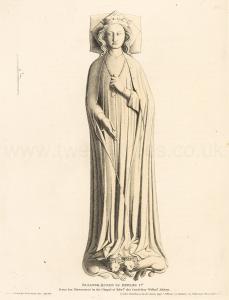Effigy of Eleanor, Queen of Edward the First
Effigy of Eleanor, Queen of Edward the First is in Monumental Effigies of Great Britain.
ELEANOR, Queen of Edward the First, was the daughter of Ferdinand the Third, King of Castile, and only child of his second wifea, Joan, daughter and heiress of John Earl of Ponthieu. She was married to him at Bures, in Spain, in 1254, and accompanied him to the Holy Land, where she is said to have preserved his life by sucking the poison out of a wound inflicted on him by the hand of an assassin. She bore him four sons and nine daughters, and died in attending him on an expedition towards Scotland, 27th November, 1290, at the house of Richard Weston, at Herdby, or Harby [Map], in the parish of North Clifton on the Trent, five miles from Lincoln. Her bowels were burieda in Lincoln Cathedral [Map], and her body was conveyed for interment to the Abbey Church at Westminster. At every stage where it rested the King ordered a Cross to be placed. Fifteen are enumerated as having been erected in consequence. One at Herdby, whence the procession set out; and in the chapel of which place Edward also founded a chantry for her soul. The others at Lincoln, Newark [Map], Grantham [Map], Leicester [Map], Stamford [Map], Geddington [Map], Northampton, Stony Stratford [Map], Woburn, Dunstable [Map], St. Albans, Waltham, Cheapside (London), and at the village of Charing [Map], near the Minster where she was to be entombed. Herdby, Leicester, Woburn, and Cheap, are omitted by some authorities. These Crosses were adorned with statues of the Queen. Those at Geddington, Northampton, and Waltham are extant at this day. In gothic niches in the upper part have been female figures, very similar in style to that on her tomb; on the lower, shields charged with arms of England,  Castile and León Arms, and
Castile and León Arms, and  Ponthieu Arms. Edward caused a monument to be erected to her memory near that of his father in the Confessor's Chapel, in Westminster Abbey, on which is placed her recumbent image of copper; and round the verge of the tomb the following inscription, in uncial letters:
Ponthieu Arms. Edward caused a monument to be erected to her memory near that of his father in the Confessor's Chapel, in Westminster Abbey, on which is placed her recumbent image of copper; and round the verge of the tomb the following inscription, in uncial letters:

ICY GYST ALIANOR IADIS REYNE DE ANGLETERRE, FEMME AL RE EDEWERD FtZ LE RE. OVNTIF DEL ALME DE LI DEV PVR SA PITE EYT MERCI. AMEN.
Sandford informs us that on a tablet of wood, hanging near her monument by an iron chain, were the following verses in Latin:
Nobilis Hispani jacet hie soror inclita regis, [A Spanish noblewoman lies here, the sister of a famous king]
Eximii consors Aleanora thori, [A great companion of Aleanora ?]
Edwardi primi Wallorum principis uxor, [The wife of Edward the First, Prince of Wales]
Cui pater Henricus tertius Anglus erat; [His father, Henry the Third, was an Englishman]
Hanc illi uxorem gnato petit; online princeps [He asks her to marry him; ? leader]
Legati munus suscipit ipse bono: [He himself undertakes the office of ambassador in good faith]Alphonso fratri placuit felix Hymeneus;
Germanam Edwardo nec sine dote dedit, [Not given to Edward without a dowry]
Dos preciara fuit nec tali indigna marito, [The gift was precious and not unworthy of such a husband]
Pontivo princeps munere dives erat; [? was rich in the role of prince]
Feminaconsilio prudens, pia, proie beata, [A prudent, pious, blessed woman]
Auxit amicitiis, auxit honore virum: [Who increased friendships, increasing the honor of his husband]
Disce niori. [Learn more]
Note a. In a tomb bearing her effigy of brass gilt, similar to that in Westminster Abbey, but destroyed in the Civil wars. On it was the following inscription:
HIC * SVNT * SEPVLTA * VICERA * ALIANORE * QVONDAM * REGINE * VXORIS * REGIS * EDVARDI * FILII * REGIS * HENRICI * CVIVS * ANIME * PROPICTETVR * DEVS * AMEN * PATER * NOSTER *
[Here in this sepulchre are buried the viscera of Queen Eleanor wife of King Edward I son of King Henry whose soul we give to God Amen Our Father]
The effigy of Queen Eleanor, like that of Henry the Third, is remarkable for the beauty of its execution; indeed, it may be considered one of the finest of the series of monuments given in this work. The form of the crown, and the style of the drapery, are so similar to that of the monument of Henry the Third, that it may be strongly conjectured that both effigies were executed by the same hand, under the direction of Edward the First. The features of the Queen are remarkably regular, and have an air of commanding beauty. In her right hand was probably a sceptre; her left grasps a narrow band attached to her mantle. The mantle covers both shoulders, falls over her tunic, and is gathered in well-disposed folds round her feet, which rest on two couchant lions.
